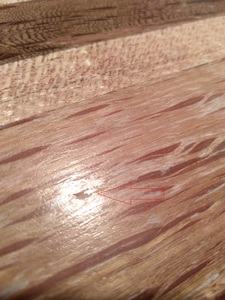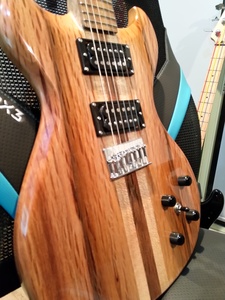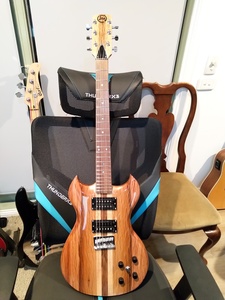Hello everyone, I need some advice.
This is my first 6-string build and my first attempt at a nitro finish.
I sanded to 400 grit and sprayed two coats of Mohawk brand sanding sealer, I then gave that a light sand and sprayed with another few coats of sanding sealer before moving onto the Mohawk brand clear lacquer. I made sure to remove any dust with compressed air, a clean rag and solvent before spraying (I used Mohawk aerosol cans).
I used 1 can of sanding sealer and 3 cans of clear lacquer for a total of 12 light coats of lacquer over 3 days.
I then waited two weeks for the lacquer to cure completely.
Next I wet block sanded starting at 1000p grit, 1200p, 1500p, 2000p.
Finally I applied some 3M polishing compound, but I cut the polishing phase short when I noticed some problems.
The finish on the side of my guitar body and the neck turned out fantastic and were coming up like glass with minimal polishing effort.
But the front and rear of the body showed areas where it appears that the wet sanding broke through the finish, you can see this in the attached pictures (it appears as white streaks where the polishing compound has stuck to the sanded through areas of the grain).
I'm assuming these are high spots in the grain that I must have neglected to get totally flat in the prep, and therefore my clear coat on the front and rear was too thin to achieve a perfectly flat surface
during the wet sanding process.
My question is, how should I proceed from here?
My assumption is that I can scuff block sand it back lightly with around 600p grit, clean off the dust and then proceed to spray many more coats of clear lacquer to build up a much thicker coat.
I now have my compressor in order and a spray gun set up, and I have ordered a large tin of lacquer, so any subsequent coats will be done with the gun rather than with aerosol cans.
If anyone has been through this type of situation before I'd be interested to hear how you resolved it.
Thanks.
Finishing is the hardest part eh?!
What you got there is a standard 'rub through'
I think you need to add 3 more coats and then repolish
In order for the color to match perfectly you may need to treat the rubbed thru areas with sealer first...anyone else want to chime in?
Where did you get your Mohawk lacquer from? Is the sealer same brand?
Measure twice, cut once...
Thanks for the reply Mark.
I've been watching your excellent streams by the way, my youtube name is eraser101yt.
I'm in Australia, I bought the lacquer from https://www.guitaraust.com.au/
The spray sealer was the same Mohawk brand.
The Mohawk brand is a rebadge, their lacquer line was previously sold under the Behlen name brand.
It seems like fine quality lacquer but I'm not too impressed with the aerosol method, considering how many cans/coats I applied it's very thin on the front and back.
I will definitely be switching over to the spray gun.
Hopefully the colour matching won't be an issue, the spray sealer and the lacquer are both clear gloss.
I agree with @markbailey you have sanded and/or polished through the lacquer. I know Mark said paint/lacquer should be thin but this is ridiculous! 😊
Joking aside, just sand the localised areas that are affected, clean, reapply sealer, flatten off carefully, reapply lacquer (a good few coats). Leave it to cure before flattening, very carefully this time. Remember that when you are polishing with compound that you are still removing lacquer, it is abrasive. Don't polish in one spot for too long, move around all the time. However you are polishing, whether it's by hand of machine, movement creates friction and friction creates heat. If you build up too much heat, you will burn through the lacquer easier and faster. That's the golden rule, keep moving. Painting and polishing are two different arts.
Good luck and keep us informed of your progress.
Make guitars, not war 🌍✌️🎸
Thanks Boo, those are good tips.
I gave all sides the same treatment, but the rub through only happened on the front and back while the sides and neck turned out perfect.
It also rubbed through during the wet sanding process despite applying little to no pressure and starting at 1000p grit.
The only polishing I did was by hand with a foam pad so there was no serious heat generated.
Honestly I blame something I did with the aerosol spraying technique, I was going for lots of light coats to avoid drips and runs but I think I applied it too thin on the front and back.
When I sprayed the sides and neck I must have had the can closer because I was spraying a narrower section (as opposed to the front and back of the body).
If it all turned out like it did on the sides & neck I'd be happy with the result and the sanding and polishing process that I used.
Live and learn, I didn't expect to get finishing perfect the first time.
It's going to take a few weeks but I'll update this post with the results once I get it resprayed.
@julian
I noticed that you block sanded and think this might be part of the reason why you rubbed through i.e. using wet and dry paper around a hard block will tend to dig in as you rub. I often use a sponge to wrap the paper as it gives a much softer feel. I've also got some experience of violin making and finishing where Tripoli powder (Jewellers Rouge) is used to rub down between coats mixed with water and applied with a soft cloth. There's much less chance of rubbing through with this method because it's not as severe. Obviously the residue needs to be well cleaned before new coats are sprayed. I have even seen one violin maker rub with dry powdered Vienna chalk between coats of oil varnish. The surface should already be flatted after grain filling, so all you really want to do is remove the glossy shine between coats. Final polishing of the top coat will give a shine if that's what you want, although I was told once by a paint shop supplier that high gloss nitro is dependant on the quality of the thinners used. Make sure it's spray and not brushing thinners.
Some people call me a tool, others are less complimentary. Tools being useful things.
Thanks for the advice.
I'll try with the sponge rather than the hard block on my next attempt.
@markbailey @rocknroller912 @boo @cheesewhisk @Deej @robin
Thanks again guys for the advice, here's a final update for this thread.
It's all finished now, it's not perfection (I've got room for improvement on my pore filling technique) but it turned out pretty good and I'm happy with it as my first attempt at a nitro finish.
5 coats with the spray gun, wet sand 1000p, 1200p, 1500p then
3M 1,2,3 cut and polish compounds with foam pads and cloth wheel.











